How to Get Started in Cardistry: A Beginners' Guide to Card Flourishes
Sleight of hand card tricks and card flourishing have been closely linked for centuries. However, over the last decade, an influx of incredibly innovative and talented playing card handlers have truly evolved what can be accomplished with a simple deck of cards. This amazing art form known as cardistry has taken the world by storm and you can start learning it today! Sure, there will always be room in the world for mind reading, coin magic, Zoom magic and other magic that you can get from magic stores or magic conventions. People will always buy flash paper and there's always going to be people who want to learn magic tricks - from bar bets to get a free drink to card magic basics. But in the corner of magic conventions around the world, they'll be someone showing off the latest cardistry rather than talking about magic tricks.
What Is Cardistry?
Cardistry is the “performance art of card flourishing” where a deck of playing cards is manipulated with cuts, pivots, spins, twirls and other creative moves that create stunning displays and visuals.
While magicians often use cardistry to spice up their favorite card magic routine, the performance art has taken on a life of its own in recent years. In fact, there is a significant percentage of cardists who focus solely on cardistry and never perform any magic tricks.
Why is Cardistry so Popular?
As cardistry is remarkably quick and visual, it thrives in our digital-focused world. It is especially popular on social media platforms like Instagram and YouTube where slickly edited videos are posted and shared at a rapid fire pace. It’s these channels that have allowed extremely talented cardists like Dan and Dave Buck (The Buck Twins), Andrei Jikh, Zach Mueller and Salvador González to help spread cardistry around the world.
The cardistry community is also incredibly active and regularly collaborates to push the art form forward. New moves and displays are regularly being created and there is even an annual international cardistry convention know as Cardistry-Con that brings together some of the best cardists and cardistry playing cards suppliers in the world.
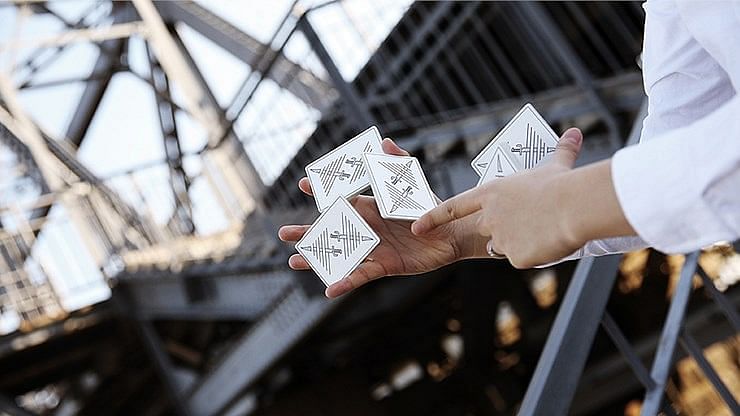
The Best Decks of Cards for Cardistry
Before you even attempt a Five Faces of Sybil Cut or Waterfall Flourish, you need to be sure you have the right tools. For a cardist, this means having a deck of cards that handles well and is built to perform.
There are a variety of special decks built exclusively for cardistry that feature outstandingly vibrant colors and distinct illustrations designed to enhance visuals. However, as a beginner in cardistry, you’ll be dropping and ruining a lot of playing cards. So, it’s important to start with a deck of cards that meets your needs without breaking the bank.
Standard Bicycle Playing Cards, Tally-Ho Playing Cards and Copag Playing Cards are inexpensive, exceptional quality decks cards that are perfect for anyone new to cardistry. They are poker-sized and have the embossed air-cushion finish needed to ensure the cards flow smoothly and evenly over each other. As an added bonus, most magicians probably already own decks of cards like these.
Tips for Finding the Best Deck of Cardistry Playing Cards:
- Don’t use inferior knock-off budget decks of cards or souvenir decks of cards. These will often be extremely rigid and have an overly smooth finish that prevents them from fanning or spreading evenly, leading to disappointment and frustration.
- Try to used poker-sized playing cards instead of bridge-sized playing cards, as bridge-sized playing cards are narrower and limit the type of flourishes you can do.
- While a slightly worn-in deck of cards will work better than a brand new deck of cards, you want to avoid using one that is old and tattered. These overused playing cards will clump together and cause inconsistent handling.
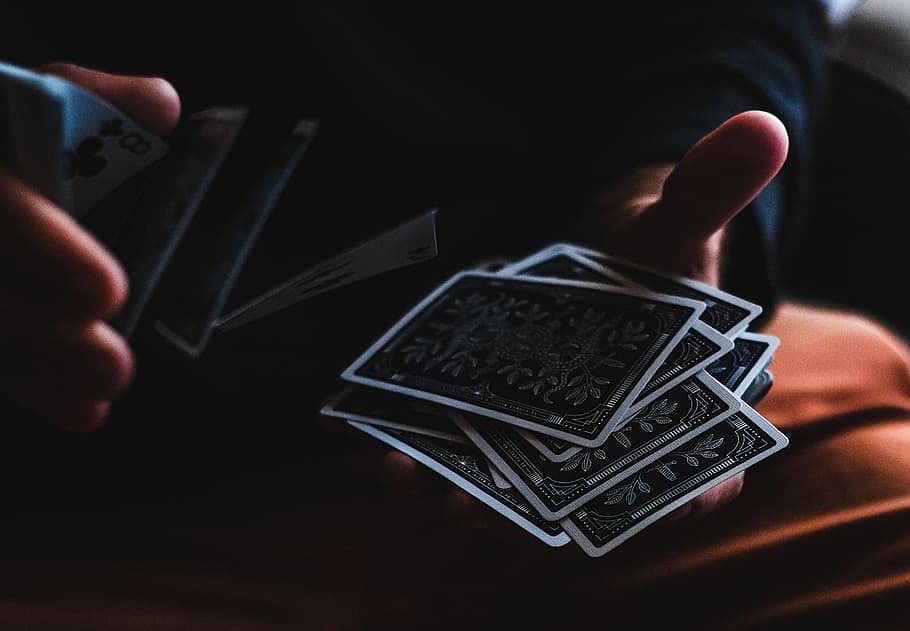
How to Maintain Your Playing Cards
Your playing cards will eventually wear out. That’s why cardists often buy playing cards in “bricks” (12 decks at a time). Beyond being more convenient, the average price per deck in a brick of cards is typically cheaper than buying them individually.
Tips for Making Playing Cards Last Longer
- Always have clean and dry hands when using your playing cards.
- Practice indoors when possible and over a soft surface like a carpet.
- Avoid moisture and humidity.
- Don’t leave your playing cards in direct sunlight
- Occasionally riffle shuffle the deck both face up and face down to ensure an even bend.
- If your cards do get warped, place them under some heavy books or in a card clip
- If you drop your cards on the ground, pick them up one by one. Sweeping them up in big clumps can cause dirt and dust to get trapped in the deck.
How To Learn Cardistry
There are a ton of incredible resources online for beginner cardistry tutorials. YouTube channels like School of Cardistry, Fontaine Cardistry, Cardistry Touch and Best Cardist Alive are excellent places to learn cardistry basics.
Once you have your basics down, you can then explore the array of premium content available to help take your cardistry to new levels. For example, The Trilogy from the Buck Twins is considered an absolute “must watch” for any cardist—particularly the Flourishes and Everythingelse volumes. You can access these in our our magic downloads section alongside countless other awesome videos like:
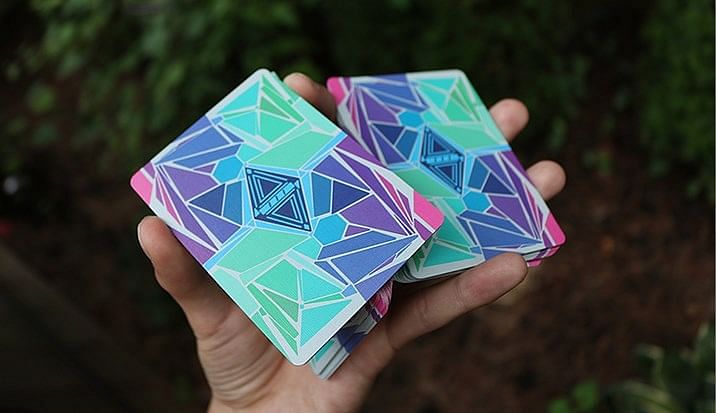
Cardistry Terms You Should Know
Cardistry has its own unique language that you’ll need to learn. While words like packet, cut, fan and spread might be easy to figure out, others might be a bit less obvious:
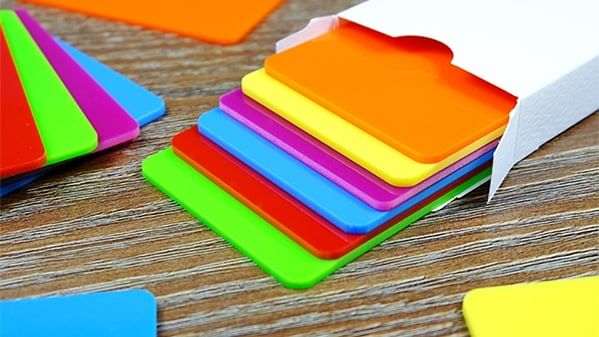
- OH: shorthand for “one handed”
- Stock: the type of paper that the cards are printed on
- Finish: the varnish applied to the front and back of the cards (popular finishes include the USPCC’s Magic Finish or Copag’s True Linen B9 )
- Knacky: a term used to describe a difficult move to learn that requires a lot of practice before it ‘clicks’ into place
- Jam: a meetup between cardists either online or in person
- Poop Deck: a deck of cards that has been extensively used/worn
- Squids/Planks/Trainers: blocks of hard material in the shape of a packet of cards designed for practicing cardistry
How to Practice and Improve your Cardistry
1. Walk Before You Run
Just like when you learn [sleight of hand]/sleight-of-hand], anybody with a deck of cards can start learning cardistry moves and card flourishes. You’re only limited by your imagination, creativity and commitment. However, you’ll never truly grow if you don’t take the necessary time to learn the basics such as the:
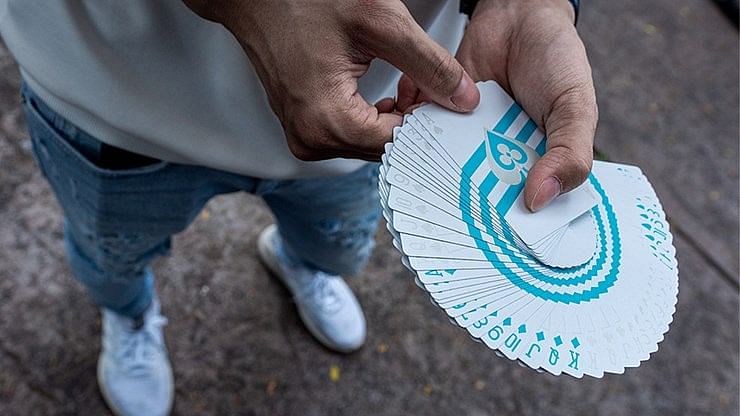
- Swing Cut
- Card spring
- Charlier Cut
- Thumb Fan
- Pressure Fan
- Faro Shuffle
- Sybil Cut
- Werm
- Hot Shot Cut
Learning the basics allows you to get familiar with the rotations and hand placements needed to build the necessary foundation for advanced cardistry moves. Once you’ve mastered these, you can gradually start learning more difficult cardistry moves. Eventually, you may even be able to create your own moves.
2. Don’t Rush
Just like when learning a new card magic trick, you should always prioritize smoothness over speed when learning a new cardistry move. Start slow and focus on ensuring every little aspect of the move is conducted smoothly and properly. Your speed will naturally pick up over time as you become more comfortable.
3. Immerse Yourself in the Online Cardistry Community
Watching a talented cardist in action is like poetry in motion. That’s why it’s important to follow your favorite cardists on social media. This will help you uncover fresh ideas and motivate yourself to improve.
Cardists are also extremely passionate about their art and are typically thrilled to talk about cardistry with you. If you’re having trouble learning something, don’t be afraid to ask for help. There are a ton of cardistry forums where you can post videos and ask for advice or tips. These forums are also where cardists exchange ideas, discuss their favorite decks and share videos of their news moves. If you’re looking for a place to start, we’d suggest /r/Cardistry on Reddit. Nearly 80,000 cardists are already subscribed, and it’s growing every day.
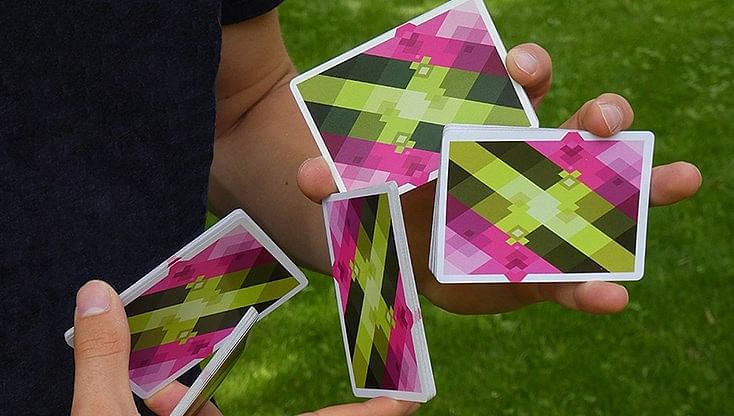
4. Practice, Practice and Practice
Anyone can pick up a deck of cards and start learning cardistry. But, only those willing to put in the work will ever succeed. Many moves will feel incredibly awkward at first. However, the only way to get them to look and feel natural is to continue practicing until your fingers build up the dexterity and muscle memory. You’ll be surprised at how much easier things get as you build upon your overall skill set.
Always keep a deck of cards in your pocket or backpack so you can practice at any time. Whether you’re watching TV or on a long car ride, take advantage of down time to work on some killer card flourishes.
You can also use cardistry trainers. These acrylic blocks are the same shape as a playing card with a thickness that’s about the same as a packet of 10-12 cards. Cardistry trainers like Fiber Boards Cardistry Trainers and Edge Jelly Cardistry Trainers allow you to explore new and difficult moves and practice your cardistry technique anywhere without having to worry about ruining your cards. As an added bonus, if you drop your cards while trying a difficult move, you only have to pick up 6-7 blocks as opposed to 52 cards!
5. Never Give Up
This is probably the most important rule of cardistry. While cardistry is a tremendously rewarding and enjoyable creative outlet, it can also be frustrating at times. However, these challenges should be a welcomed part of the journey.
Some moves are knacky and take a while to set in. It’s important to not give up during these times. If you’re really struggling, move on to something else for a couple days or a week. When you come back to it, you might be surprised to find your muscle memory flows a bit easier. There’s no better feeling than finally tackling a move that has been giving you trouble.
